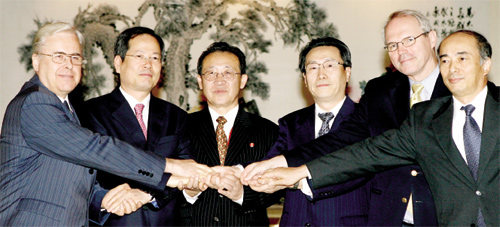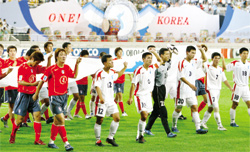The South Korean Government has designated making a breakthrough in the North Korean nuclear issue through the Six-Party Talks ― involving the Koreas, the United States, China, Russia and Japan ― as the core task of its security policy. It is pursuing advancements in inter-Korean relations as a catalyst for the resolution of the nuclear issue.
|

|
| Envoys from six nations pose for a group photo during their North Korean nuclear disarmament meeting in Beijing, China, 30 September 2007. |
Thanks to these efforts to resolve the North Korean nuclear issue through dialogue, the fourth round of the Six-Party Talks adopted a six-point Joint Statement on September 19, 2005. It dealt with the abandoning of nuclear weapons by North Korea and implementing principles. The Joint Statement was followed by the adoption of a Chairman's Statement at the fifth round of the Six-Party Talks in November 2005. It reaffirmed the commitment of the participating countries to the implementation of the September 19 Joint Statement.
The Six-Party Talks were hindered by confrontation between the United States and North Korea over U.S. financial sanctions against the North and North Korea's counterfeiting of U.S. dollars. In addition, after North Korea test-fired missiles on July 5, 2006, and conducted a nuclear test on October 9, 2006, the nuclear problem entered a tense phase. In close cooperation with the international community, the South Korean Government took its own countermeasures toward the North, including suspension of rice and fertilizer aid. Recognizing the fact that resuming the Six-Party Talks as soon as possible was essential to finding a fundamental solution to the nuclear problem, the South Korean Government exerted diplomatic efforts to that end. As a result, the second session of the fifth round of the Six-Party Talks was held on December 18, 2006 and the third session was held from February 8, 2007.

An inter-Korean men's friendly soccer game
In 2007, progress to dismantle the North Korean nuclear facilities took place amid cooperation between the six nations. The concerned countries agreed through the Feb. 13 Agreement and the Oct. 3 Agreement to close and seal North Korean nuclear facilities. They also outlined "first-phase measures" to implement the Sept. 19 Joint Agreement, including declaring nuclear disablement. The development of inter-Korean relations and progress in resolving the North Korean nuclear issue culminated with the October 2007 Inter-Korean Summit.
Inter-Korean exchanges further reconciliation and cooperation, bring peace and stability to the Korean Peninsula, and promote dialogue and cooperation between North Korea and other concerned countries. How the North Korean nuclear issue is resolved and inter-Korean relations grow will affect more than the change to a permanent peace system from the current cease-fire treaty. These developments will contribute greatly to pan-Northeast Asian security and economic cooperation. In this view, the political situation on the Korean Peninsula and throughout Northeast Asia is at a turning point; moving toward peace and prosperity.